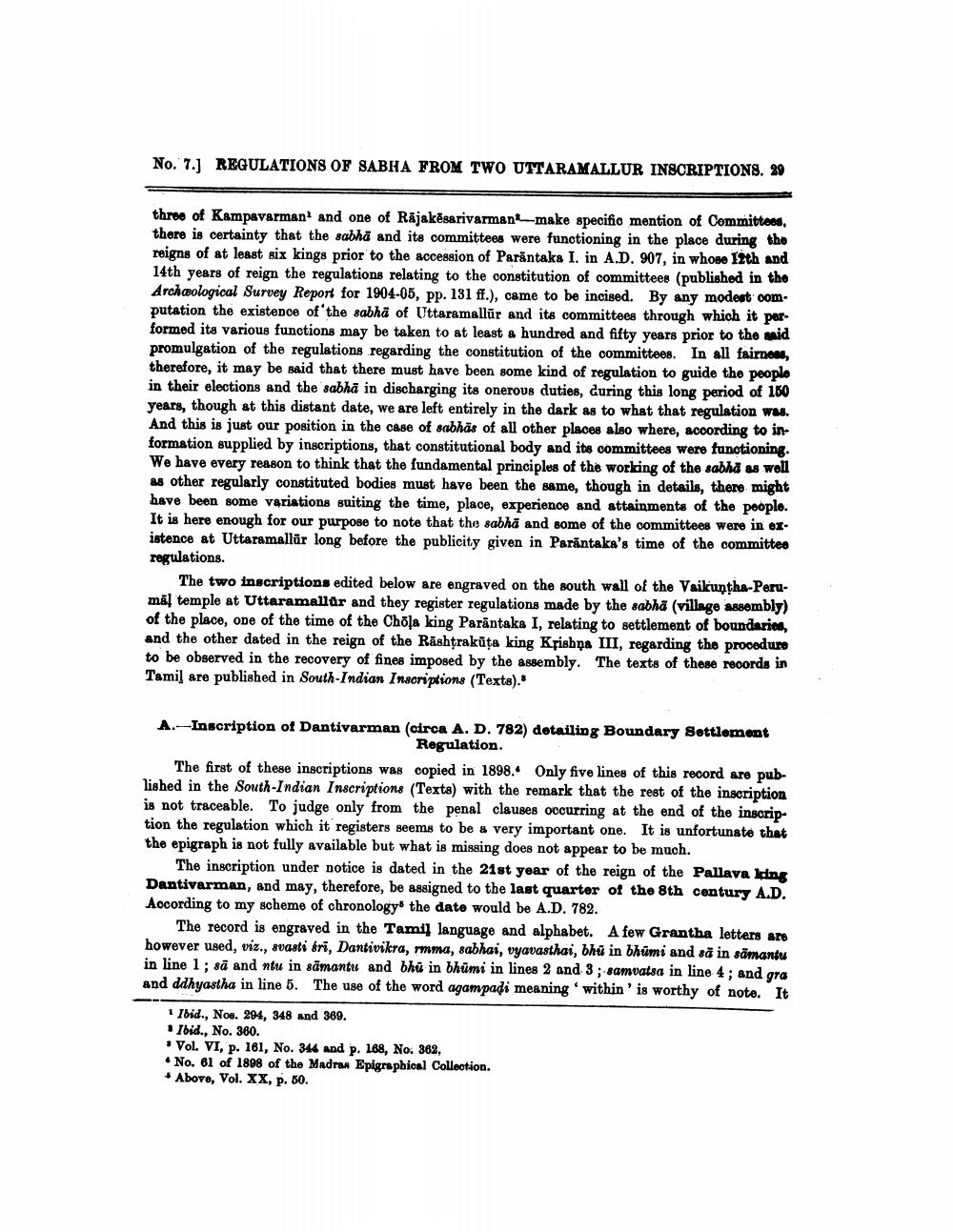________________
No. 7.) REGULATIONS OF SABHA FROM TWO UTTARAMALLUR INSCRIPTIONS. 29
three of Kampavarman and one of Rājakësarivarman-make specific mention of Committees there is certainty that the sabha and its committees were functioning in the place during the reigns of at least six kings prior to the accession of Parantaka I. in A.D. 907, in whose 12th and 14th years of reign the regulations relating to the constitution of committees (published in the Archæological Survey Report for 1904-05, pp. 131 ff.), came to be incised. By any modest computation the existence of the sabha of Uttaramallúr and its committees through which it performed its various functions may be taken to at least a hundred and fifty years prior to the mid promulgation of the regulations regarding the constitution of the committees. In all fairness, therefore, it may be said that there must have been some kind of regulation to guide the people in their elections and the sabha in discharging its onerous duties, during this long period of 150 years, though at this distant date, we are left entirely in the dark as to what that regulation was And this is just our position in the case of sabhäs of all other places also where, according to information supplied by inscriptions, that constitutional body and its committees were functioning. We have every reason to think that the fundamental principles of the working of the sabha as well as other regularly constituted bodies must have been the same, though in details, there might have been some variations suiting the time, place, experience and attainments of the people. It is here enough for our purpose to note that the sabha and some of the committees were in 61istence at Uttaramallär long before the publicity given in Parantaka's time of the committes regulations.
The two inscriptions edited below are engraved on the south wall of the Vaikuntha-Perumal temple at Uttaramallar and they register regulations made by the sabha (village assembly) of the place, one of the time of the Chola king Parāntaka I, relating to settlement of boundaries, and the other dated in the reign of the Rashtrakūta king Krishna III, regarding the procedure to be observed in the recovery of fines imposed by the assembly. The texts of these records in Tamil are published in South Indian Inscriptions (Texts)."
A.- Inscription of Dantivarman (circa A. D. 782) detailing Boundary Sottlement
Regulation. The first of these inscriptions was copied in 1898. Only five lines of this record are published in the South Indian Inscriptions (Texts) with the remark that the rest of the inscription is not traceable. To judge only from the penal clauses occurring at the end of the inscription the regulation which it registers seems to be a very important one. It is unfortunate that the epigraph is not fully available but what is missing does not appear to be much.
The inscription under notice is dated in the 21st year of the reign of the Pallava Iding Dantivarman, and may, therefore, be assigned to the last quarter of the 8th century A.D. According to my scheme of chronology the date would be A.D. 782
The record is engraved in the Tamil language and alphabet. A few Grantha letters are however used, viz., svasti trī, Dantivikra, mmma, sabhai, vyavasthai, bhù in bhumi and să in sämantu in line 1; să and ntu in sämantu and bhù in bhūmi in lines 2 and 3 ; samvatsa in line 4; and gra and ddhyastha in line 5. The use of the word agampadi meaning within' is worthy of note. It
1 Ibid., Noe. 294, 348 and 369. * Ibid., No. 360. • Vol. VI, p. 161, No. 344 and p. 168, No. 362, • No. 61 of 1898 of the Madran Epigraphical Collection. * Above, Vol. XX, p. 60.




